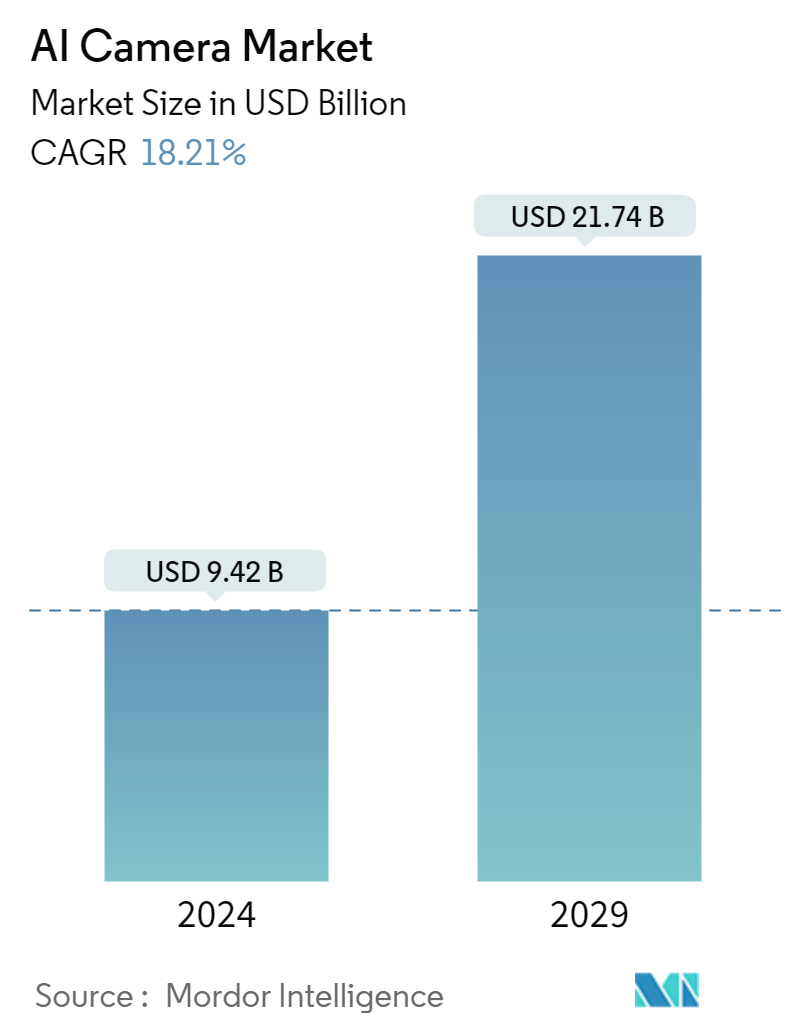Market Size of AI Camera Industry

| Study Period | 2019 - 2029 |
| Market Size (2024) | USD 9.42 Billion |
| Market Size (2029) | USD 21.74 Billion |
| CAGR (2024 - 2029) | 18.21 % |
| Fastest Growing Market | North America |
| Largest Market | Asia Pacific |
| Market Concentration | Low |
Major Players
*Disclaimer: Major Players sorted in no particular order |
AI Camera Market Analysis
The AI Camera Market size is estimated at USD 9.42 billion in 2024, and is expected to reach USD 21.74 billion by 2029, growing at a CAGR of 18.21% during the forecast period (2024-2029).
- AI cameras are witnessing a growing demand due to the increasing need for safety and versatile applications. These devices are pivotal in enhancing public safety, with applications spanning traffic management, accident detection, and disaster response. AI cameras effectively shorten response times to security incidents by providing real-time analysis and alerts. In addition, AI security cameras are increasingly pivotal in enhancing security, curbing crime, and offering crucial data for informed decision-making, fueling the market's growth.
- In May 2024, Maharashtra, India, announced its plans to deploy a series of artificial intelligence (AI) cameras across all highways. This initiative aims to reduce accidents and fatalities throughout the state. Maharashtra approved the installation of AI cameras on nine of its highways. These advanced cameras are designed to detect a range of common road offences. Such offences encompass speeding, lane cutting, driving on the wrong side, and even using mobile phones while driving. Equipped with sophisticated sensors and software, the AI-powered cameras can analyze live footage, recognize number plates, and identify traffic anomalies in real-time.
- AI cameras are transforming patient monitoring in the healthcare sector, while in retail, they play a crucial role in analyzing customer behaviour. AI cameras enhance quality control in manufacturing, underscoring the technology's versatility and adaptability. In December 2023, HonorHealth sought AI solutions to analyze camera footage.
- The company aims to leverage AI to receive alerts, reducing the need to review each camera feed or retrace the steps manually. AI can detect anomalies, like a visitor donning a heavy coat in Arizona's sweltering 100-degree heat. Moreover, while facial recognition proves beneficial, the capability to identify objects, such as an unoccupied wheelchair in a hallway or a neglected wet floor, plays a crucial role in accident prevention.
- AI cameras help monitor public spaces, identify potential threats, and assist law enforcement in criminal investigations, leading to increased adoption by municipalities and government agencies. In July 2024, Britain launched a new generation of AI-driven speed cameras to enhance road safety. These advanced cameras will monitor and catch drivers for speeding, mobile phone usage, and seatbelt violations. Greenlit by the Department for Transport, this initiative aims to strengthen driving law enforcement and mitigate hazardous driving behaviours nationwide.
- AI cameras generate and store large amounts of data, making them targets for cyberattacks. Concerns over data breaches and the security of sensitive information can deter organizations from adopting AI cameras. In addition, increasing regulations related to data privacy (such as GDPR in Europe) and surveillance could restrict the deployment and usage of AI cameras. Compliance with these regulations can be costly and complex. Moreover, AI cameras generally require more power compared to traditional cameras due to the processing capabilities they support. This can be a militing factor in remote or off-grid locations.
- Macroeconomic factors like regulations governing the use of surveillance technology can limit the deployment of AI cameras. These laws may restrict where and how AI cameras can be used, affecting market expansion, especially in public and sensitive areas. Moreover, positive international relations facilitate cross-border investments, technology transfers, and joint ventures, driving innovation and growth in the AI camera market. Conversely, strained relations can lead to trade restrictions, limiting market expansion.

